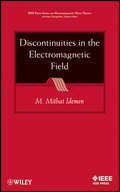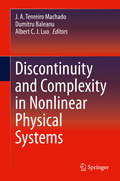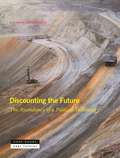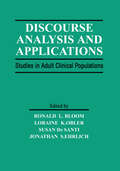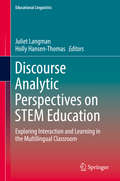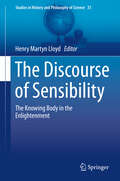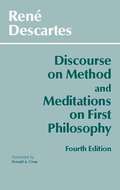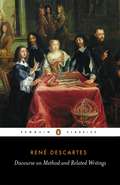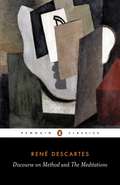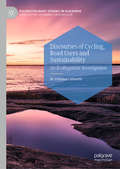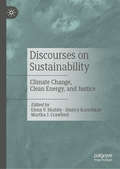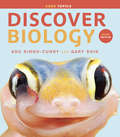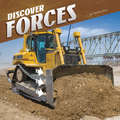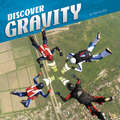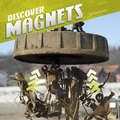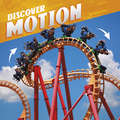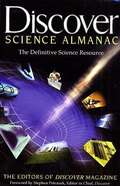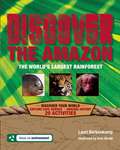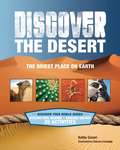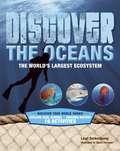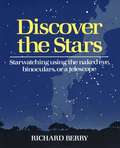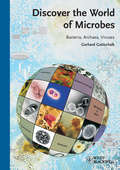- Table View
- List View
Discontinuities in the electromagnetic field
by Idemen M. MithatA multifaceted approach to understanding, calculating, and managing electromagnetic discontinuities Presenting new, innovative approaches alongside basic results, this text helps readers better understand, calculate, and manage the discontinuities that occur within the electromagnetic field. Among the electromagnetic discontinuities explored in this volume are: Bounded jump discontinuities at the interfaces between two media or on the material sheets that model very thin layers Unbounded values at the edges of wedge-type structures Unbounded values at the tips of conical structures The text examines all the key issues related to the bodies that carry the interfaces, edges, or tips, whether these bodies are at rest or in motion with respect to an observer. In addition to its clear explanations, the text offers plenty of step-by-step examples to clarify complex theory and calculations. Moreover, readers are encouraged to fine-tune their skills and knowledge by solving the text's problem sets. Three fundamental, classical theories serve as the foundation for this text: distributions, confluence, and the special theory of relativity. The text sets forth the fundamentals of all three of these theories for readers who are not fully familiar with them. Moreover, the author demonstrates how to solve electromagnetic discontinuity problems by seamlessly combining all three theories into a single approach. With this text as their guide, readers can apply a unique philosophy and approach to the investigation and development of structures that have the potential to enhance the capabilities of electronics, antennas, microwaves, acoustics, medicine, and many more application areas.
Discontinuity and Complexity in Nonlinear Physical Systems
by J. A. Tenreiro Machado Dumitru Baleanu Albert C J LuoDiscontinuity in Nonlinear Physical Systems explores recent developments in experimental research in this broad field, organized in four distinct sections. Part I introduces the reader to the fractional dynamics and Lie group analysis for nonlinear partial differential equations. Part II covers chaos and complexity in nonlinear Hamiltonian systems, important to understand the resonance interactions in nonlinear dynamical systems, such as Tsunami waves and wildfire propagations; as well as Lev flights in chaotic trajectories, dynamical system synchronization and DNA information complexity analysis. Part III examines chaos and periodic motions in discontinuous dynamical systems, extensively present in a range of systems, including piecewise linear systems, vibro-impact systems and drilling systems in engineering. And in Part IV, engineering and financial nonlinearity are discussed. The mechanism of shock wave with saddle-node bifurcation and rotating disk stability will be presented, and the financial nonlinear models will be discussed.
Discounting the Future: The Ascendancy of a Political Technology
by Liliana DoganovaA pioneering exploration of the defining traits and contradictions of our relationship to the future through the lens of discountingForest fires, droughts, and rising sea levels beg a nagging question: have we lost our capacity to act on the future? Liliana Doganova&’s book sheds new light on this anxious query. It argues that our relationship to the future has been trapped in the gears of a device called discounting. While its incidence remains little known, discounting has long been entrenched in market and policy practices, shaping the ways firms and governments look to the future and make decisions accordingly. Thus, a sociological account of discounting formulas has become urgent.Discounting means valuing things through the flows of costs and benefits that they are likely to generate in the future, with these future flows being literally dis-counted as they are translated in the present. How have we come to think of the future, and of valuation, in such terms? Building on original empirical research in the historical sociology of discounting, Doganova takes us to some of the sites and moments in which discounting took shape and gained momentum: valuation of European forests in the eighteenth and nineteenth centuries; economic theories devised in the early 1900s; debates over business strategies in the postwar era; investor-state disputes over the nationalization of natural resources; and drug development in the biopharmaceutical industry today. Weaving these threads together, the book pleads for an understanding of discounting as a political technology, and of the future as a contested domain.
Discourse Analysis and Applications: Studies in Adult Clinical Populations
by Ronald L. Bloom Loraine K. Obler Susan De Santi Jonathan S. EhrlichApplication of analytic discourse techniques to clinical practice is relatively recent. This book's contributors begin with the notion that systematic examination of discourse provides a rich source of data for describing the complex relationships among language, social context, and the cognitive processes that underlie discourse comprehension and production. Evidence is provided that when discourse is studied across different clinical populations, analysis yields an optimal opportunity for developing dynamic models of brain and language that more thoroughly account for the complexity of language use in social contexts. Accordingly, studies presented in this volume have a dual focus -- to examine the implications of discourse research on neurolinguistic theories and to evaluate the contribution of discourse analysis to understanding the clinical status of patients with brain damage. As such, this volume reports patterns of preserved and impaired discourse behavior in normal adults and in different adult clinical populations. It also describes numerous tasks designed to elicit a variety of discourse genres and a host of techniques created to describe how subjects order information and relate ideas across sentences. In addition, it includes numerous abstract units and linguistic devices targeted to examine those aspects of discourse that govern cohesion, organization, and topic manipulation. This volume is unique because it presents both theoretical and clinical papers that examine a variety of communication pathologies. Clinicians often report dissatisfaction with formal test batteries in that results are often at variance with clinical observation of performance in real life situations. To address this concern, this work proposes methods for examining discourse that move the examiner closer to naturalistic sampling. The research presented demonstrates that discourse analysis provides clinically significant information that contributes to the understanding of the cognitive, linguistic, and social status of people with communication disorders. These studies also offer a framework to support continuously evolving diagnostic and treatment paradigms for adults with neurological communication pathologies.
Discourse Analytic Perspectives on STEM Education
by Juliet Langman Holly Hansen-ThomasThis volume explores the nature of discourse in secondary and upper elementary mathematics and science classrooms. Chapters examine conditions that support or hinder teachers and students, in particular language learners, in employing language as a tool for learning. The volume provides rich oral and written language examples from a range of classroom contexts to illustrate how linguistic practices affect students' appropriation and display of disciplinary specific knowledge. Chapters further explore linguistic practices through with the support of discourse analytic models that foreground the authentic classroom data with the aim of understanding the dynamics of the classroom. The authors investigate the intersection between discourse and learning from a range of perspectives, including an examination of key concepts such as intertextuality, interaction, mediation, scaffolding, appropriation, and adaptations. This volume offers concrete suggestions on how teachers might benefit from a discourse approach to teaching in the areas of mathematics and science.
The Discourse of Sensibility
by Henry Martyn LloydThis volume reconstructs the body of sensibility and the discourse which constructed it. The discourse of sensibility was deployed very widely throughout the mid- to late-eighteenth century, particularly in France and Britain. To inquire into the body of sensibility is then necessarily to enter into an interdisciplinary space and so to invite the plurality of methodological approaches which this collection exemplifies. The chapters collected here draw together the histories of literature and aesthetics, metaphysics and epistemology, moral theory, medicine, and cultural history. Together, they contribute to four major themes: First, the collection reconstructs various modes by which the sympathetic subject was construed or scripted, including through the theatre, poetry, literature, and medical and philosophical treaties. It secondly draws out those techniques of affective pedagogy which were implied by the medicalisation of the knowing body, and thirdly highlights the manner in which the body of sensibility was constructed as simultaneously particular and universal. Finally, it illustrates the 'centrifugal forces' at play within the discourse, and the anxiety which often accompanied them. At the centre of eighteenth-century thought was a very particular object: the body of sensibility, the Enlightenment's knowing body. The persona of the knowledge-seeker was constructed by drawing together mind and matter, thought and feeling. And so where the Enlightenment thinker is generally associated with reason, truth-telling, and social and political reform, the Enlightenment is also known for its valorisation of emotion. During the period, intellectual pursuits were envisioned as having a distinctly embodied and emotional aspect. The body of 'sensibility' encompassed these apparently disparate strands and was associated with terms including 'sentimental', 'sentiment', 'sense', 'sensation', and 'sympathy'.
Discourse on Method and Meditations on First Philosophy (4th Edition)
by René Descartes Donald A. CressThis new edition contains Donald Cress' completely revised translation of the Meditations (from the corrected Latin edition) and recent corrections to Discourse on Method, bringing this version even closer to Descartes' original....
Discourse on Method and Related Writings
by René DescartesThis is the second of a new two-volume edition of the works of Descartes in Penguin Classics. This volume is designed for students who approach Descartes from the point of view of his philosophy of science. Includes DISCOURSE ON METHOD, the most accessible and well-known of his discussions of scientific method; the first seven chapters of the earlier, unpublished work, THE WORLD; as well as a selection of Descartes' correspondence and his replies to his critics.
Discourse On Method and Related Writings
by René Descartes Desmond M. ClarkeDescartes' Discourse on Methodhas long been regarded as a seminal contribution to modern philosophy. We can now see that it is also one of the key texts in the 'scientific revolution' of the seventeenth century. Rene Descartes (1596-1650) did major research in optics, geometry, astronomy and physiology, although he published nothing until he was over forty. The Discourseforms the preface to his first collection of scientific papers (1637), sketching in a new method based on hypothesis and deduction which was soon to replace traditional techniques derived from Aristotle. This edition puts the work in context, by including extracts from Descartes' correspondence, the Rules for Guiding One's Intelligenceand from The World- a posthumously published summary of his physical theories. The age of Newton marks one of the great turning points in intellectual history; Descartes has a key place at its very heart. Also by Descartes is the companion volume, Meditations and other Metaphysical Writings.
Discourse on Method and the Meditations: And Meditations On The First Philosophy (Barnes And Noble Library Of Essential Reading Ser.)
by René DescartesRené Descartes was a central figure in the scientific revolution of the seventeenth century. In his Discourse on Method he outlined the contrast between mathematics and experimental sciences, and the extent to which each one can achieve certainty. Drawing on his own work in geometry, optics, astronomy and physiology, Descartes developed the hypothetical method that characterizes modern science, and this soon came to replace the traditional techniques derived from Aristotle. Many of Descartes' most radical ideas - such as the disparity between our perceptions and the realities that cause them - have been highly influential in the development of modern philosophy.
Discourses of Cycling, Road Users and Sustainability: An Ecolinguistic Investigation (Postdisciplinary Studies in Discourse)
by M. Cristina CaimottoThis book employs a Critical Discourse Studies (CDS) framework to examine cycling mobility, marking a new turn in ecolinguistic discourse analysis. The author focuses specifically on environment-related arguments concerning the promotion of higher levels of cycling, mainly as a means of transport, and investigates the “US vs. “THEM” narratives present in many discourses about road users. Analysing newspaper articles, institutional documents and spoken interviews, the author searches for a positive new discourse that would inspire and encourage cycling as a habitual means of transport, rather than simply exposing ecologically destructive discourse. The book will be of interest to discourse and ecolingusitics scholars, as well as contributing to the lively debate about how to increase cycling in fields such as sustainability, sociology, transport planning and management.
Discourses on Sustainability: Climate Change, Clean Energy, and Justice
by Elena V. Shabliy Dmitry Kurochkin Martha J. CrawfordThis volume presents an in-depth analysis of climate change problems and discusses the proliferation of renewable energy worldwide—in conjunction with such important questions as social justice and economic growth, providing an interdisciplinary approach to sustainable development. Exploring various responses to human-induced climate change, the book offers a critical reflection on climate change and clean energy and highlights the fundamental problems of international energy justice and human rights. Examining these and other climate-related issues from legal, business, political, and scientific perspectives, the volume also analyzes the impact of economic factors and policies on climate change mitigation and adaptation.
Discover Biology (Sixth Edition)
by Anu Singh-Cundy Gary ShinDiscover Biology facilitates the active learning of science in and out of class. It advocates for "Scientific literacy through active learning. before, in and after class." ,,, for this to be achieved, students must retain the core concepts learnt in class.
Discover Forces (Discover Physical Science)
by Tammy EnzHow do you get something to move? You use force to move it with a push or a pull. With this basic introduction to forces, young readers will learn about physical forces and how they are at work in our world every day.
Discover Gravity (Discover Physical Science)
by Tammy EnzWhat would happen if gravity didn't exist? People and objects would float into space! With this basic introduction to gravity, young readers will discover how gravity works and how it affects everything in our world and beyond.
Discover Magnets (Discover Physical Science)
by Tammy EnzWhat would our world be like without magnets? Computers, radios, phones, and TVs wouldn't work correctly. And many other modern machines wouldn't exist. With this basic introduction to magnets, young readers will learn how magnets work and how useful they are our world today.
Discover Motion (Discover Physical Science)
by Tammy EnzTake a look out the window. What do you see? People, cars, bikes, birds, and more are all on the move. With this basic introduction to motion, young readers will discover the three laws of motion, what they mean, and how they affect our lives every day.
Discover Science
by Michael R. Cohen Timothy M. Cooney Alan J. Mccormack Jay M. Pasachoff Naomi Pasachoff Irwin L. Slesnick Cheryl M. Hawthorne Karin L. RhinesDiscover Science Almanac
by Bryan Bunch Jenny TesarThe first and only science reference book of its kind features the latest breakthroughs in science--from technology to medicine. 50 illustrations.
Discover the Amazon
by Lauri Berkenkamp Blair SheddFrom avoiding predators to navigating through the jungle without a compass, this innovative guide provides kids with the vital tools one would need if lost in the Amazon. Offering practical survival techniques based on real stories, children will learn lessons that can be adapted to almost any outdoor situation, such as making fire, deciphering animal tracks, and using the natural world for all to create necessary supplies. Opening with an informative section on the region and its people, this essential resource combines history and science in a fun and engaging way. Facts and sidebars on the local creatures and plants are interspersed along with 15 activities for the home or classroom-from making a fishing spear to determining how much water is needed to stay healthy.
Discover the Desert
by Sam Carbaugh Kathryn CeceriDelving into a seemingly dry and barren ecosystem, this fun-filled activity book closely examines the desert landscape and shows how many exciting discoveries it holds. Exploring native plants and animals and depicting the extreme temperatures, rough terrain, and vast distances in detail, this lively reference describes lost civilizations as well as today's desert-dwelling cultures. "Try This" science and history activities are also included-from creating mirages and fashioning an Anasazi clay bowl to growing salt crystals and even assembling a cactus dish terrarium. Demonstrating why adventurers have always been drawn to the world's deserts, this entertaining overview also provides education on the environment, examining how the health of the planet depends on the careful treatment of the desert's many resources.
Discover the Oceans
by Chuck Forsman Lauri BerkenkampFrom both a historical and scientific point of view, above and below the surface, this engaging guide brings the world's oceans to life through fun facts, illustrations, and in-depth information. Interactive activities appear throughout, ranging from making solar stills and simple fishing spears to experimenting with a homemade diving bell and figuring out how much water it really takes to survive. With the oceans being the least explored environment on Earth, this reference illuminates some of the most incredible and surprising plants and animals as well as how to survive and navigate these vast expanses.
Discover the Stars: Starwatching Using the Naked Eye, Binoculars, or a Telescope
by Richard BerryFor everyone who has looked up at the stars on a clear night and longed to know more about them, here is the perfect introduction and guide to discovering the stars.Discover the Stars leads you on a tour of all the stars and constellations visible with the naked eye and introduces you to deep-sky objects that can be seen with binoculars or a simple telescope. The tour is conducted by the editor of Astronomy magazine, Richard Berry, whose two-color, computer-plotted sky maps and clear instructions make stargazing fun and productive from your first night out.The heart of Discover the Stars is two sections of big, beautiful sky maps and charts. The first section features twelve maps that show the entire sky overhead as it appears during each month of the year. These outline all the constellations visible anywhere in the Northern Hemisphere, and the accompanying text reveals the rich ancient mythology that surrounds the star groups.The second section is made up of twenty-three star charts that depict smaller regions of the sky in great detail. These charts give the names of key stars and lead you to fascinating features such as stars with unusual colors, double stars, variable stars, nebulae, and galaxies.Separate chapters cover basics, such as how the stars move through the sky, how to find your way around the moon and the planets, making an astronomer's flashlight, and choosing and using a telescope -- all in terms that are easy to grasp and remember.Discover the Stars is the perfect introduction to the heavens, simple enough to be useful if you're just starting out but packed with enough information to keep you learning and enjoying the stars for years to come.From the Trade Paperback edition.
Discover the World of Microbes: Bacteria, Archaea, Viruses
by Gerhard GottschalkThis title is an essential primer for all students who need some background in microbiology and want to become familiar with the universal importance of bacteria for all forms of life. Written by Gerhard Gottschalk, Fellow of the American Academy of Microbiology and one of the most prominent microbiologists in our time, this text covers the topic in its whole breadth and does not only focus on bacteria as pathogens. The book is written in an easy-to-read, entertaining style but each chapter also contains a `facts' section with compact text and diagrams for easy learning. In addition, more than 40 famous scientists, including several Nobel Prize winners, contributed sections, written specifically for this title. The book comes with color figures and a companion website with questions and answers. Key features: Unique, introductory text offering a comprehensive overview of the astonishing variety and abilities of Bacteria Easy-to-read, fascinating and educational Written by one of the best known microbiologists of our time Color images throughout Each chapter has a compact tutorial part with schemes on the biochemistry and metabolic pathways of Bacteria Comes with a companion website with questions and answers
